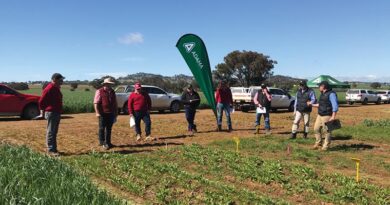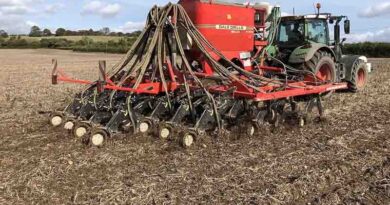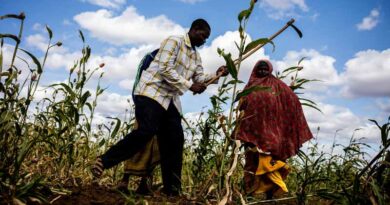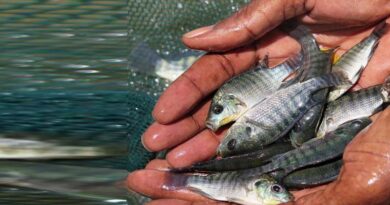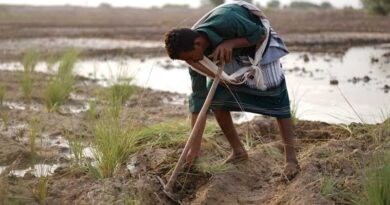Looking back on Lamport AgX 2022
01 August 2022, UK: First wheats make successful comeback at Lamport AgX as anti-blackgrass strategies prove their worth.
Agrovista welcomed hundreds of visitors to Lamport AgX, its flagship trials site in Northamptonshire, in July, giving them the chance to get up close to the wide range of innovative work being carried out at the site.
Here’s our pick of what was on offer.
A return to highly profitable early-sown winter wheat cropping is achievable on land with a history of serious blackgrass infestation, raising hopes for many growers struggling to combat this most damaging of grass weeds.
When Niall Atkinson first set eyes on the Lamport AgX trials site a decade ago, he wondered what he was getting involved with.
The silty clay soils were smothered in blackgrass, typical of this area of Northamptonshire and many other arable areas, following years of close-cropped winter wheat and oilseed rape, intensive cultivations and struggling chemistry.
“When I first saw the site it frightened the life out of me,” says Niall, consultant and trials coordinator at Lamport AgX. “I had never seen grass weeds growing like they did here. The background blackgrass population was around 2000 plants/sq m on heavy, difficult soil.”
In the event, the site has proved an ideal testing ground for the work that has since been carried out. The initial focus was blackgrass control, resulting in Agrovista’s proven technique of combining overwintered cover crops and spring cropping, which reduced blackgrass populations to single figures per square metre.
The emphasis has now switched to the wider soil health picture, examining how rotations, cover cropping and regenerative agriculture principles can interact to improve soil health and yields while maintaining blackgrass levels at manageable levels.
“We have found that soil health improvement and good grass weed control seem to go pretty much hand in hand, and we’ve created a system that works fantastically well,” says Niall.
“We’ve proved to a lot of local growers that we can grow successful spring crops on heavy, challenging soil, and control blackgrass at the same time.”
However, given the profit potential of a good first winter wheat, many farmers want to know when they can start growing it again.
“It’s a question that is even more relevant today, given the price of wheat,” Niall acknowledges. “We’ve now found that you can return to growing first wheats, but you need to stick to the guidelines or risk going backwards.”
Patience certainly pays if the results at Lamport are anything to go by. First wheats grown after a run of cover crop/spring cereals look clean and healthy, with scarcely a blackgrass head to be seen.
“I am very proud of these wheat plots and what we have achieved, knowing the extent of grassweed pressure here on this site, particularly as these are September-sown wheats, not drilled at the end of October or into November which can be fraught with problems on this land.”
Previous cropping on these plots consisted of a black oat-based cover crop followed by spring oats in 2019/20, followed by a cover crop then spring beans last season. The winter wheat was direct drilled on 28th September at 300 seeds/sq m into a cheap linseed/berseem clover catch crop that was blown into the beans.
“The main reason the catch crop was there was to provide a bit of insurance – had it turned wet, we would have had a good cover crop growing, plus volunteer beans, which could be left overwinter ahead of spring-sown wheat.”
The first wheats received full-rate chemistry to control blackgrass – Proclus Liberator and Avadex followed by full-rate flufenacet early post emergence.
“We know even new chemistry – whether Proclus or Luximo – applied in a stack is not good enough where blackgrass numbers are high,” says technical manager Mark Hemmant.
“We have to get to the stage where we’ve reduced the weed seedbank to a low enough level that herbicides can give us this sort of result.”
Niall cautions against pushing too far. “The next question growers ask is whether they can follow with a second winter wheat. We would say that is the last thing to do.
“However, we have put in winter wheat in after spring wheat. But you have to look at the previous cropping – it’s been cover crops followed by spring wheat for the past four years. We’re not advocating September sowing of the winter wheat; this was drilled on 14 October.
“There is a bit of grassweed, but nothing we can’t deal with by following with a black oat-based cover crop this autumn then spring wheat. We’ll then go back into winter wheat the following autumn.
“We could perhaps break after two or three years and put spring beans in – we’ll see where it goes. If it does work, it could be quite a nice rotation.”
Mark says the clear leader from a gross margin point of view at Lamport site is a clean crop of first winter wheat, averaging £1400/ha over the previous eight years from an average yield of 11.13t.
“But spring wheat after a cover has averaged 8.45t and given a gross margin of around £1000 in that time. That is certainly better than the £275/ha gross margin from second wheats, which averaged 6.28t/ha.
“You are locked into high input costs and losing money while making blackgrass worse again. At a site like this we would always advocate a cover crop followed by a spring crop after returning to a first wheat.”
Successful blackgrass control – the Lamport system
While Lamport AgX is putting more focus on soil health interaction and cultivations, grass weeds are always present and remain a key consideration.
Soil health improvement and good grass weed control are very much linked, says Niall. “Over the years we’ve been predominantly growing spring crops after an overwintered cover crop and that’s the way that we have got on top of grassweeds on this site.
“Choice of cover crop is very important. We don’t want to smother out blackgrass, we want it to be actively growing amongst the cover crop, so the cover crop is relatively sparse. We’re using a black oats-based mix at about 75 plants/sq m, with Phacelia probably a partner of choice. Other species such as buckwheat, linseed, berseem clover and vetches can be added to the mix.
“Black oats are fantastic at getting roots down and one of the best species to achieve good water infiltration, which is absolutely key on these heavy soils. Phacelia has a fibrous root structure that is great at conditioning soils closer to the surface.
“We then desiccate the cover crop, along with any blackgrass, around the turn of the year when the cover crop has done enough to condition the soil to enable reliable spring drilling even on heavy soils like at Lamport.”
Early desiccation is key to enable the soil surface to dry ahead of drilling – if there is too much debris it can hold moisture. The practice also helps towards releasing nutrients back into the soil.
“However, if we get a really wet late February/early March the surface of this silty clay loam can start to run together a little bit which can be detrimental to the spring-planted cash crop.
“We are continuing to look more at different destruction times of the covers, perhaps taking the bulk out roundabout Christmas time, while leaving one or two other species growing through until nearer drilling time.”
Bi-cropping potential under scrutiny
Growing a crop without any inputs apart from seed sounds too good to be true, but a bi-cropped plot of winter oats and winter beans at Lamport AgX appears to offer just that, with potentially good yields to boot.
The plot follows several years of cover crops and spring wheat, so blackgrass was not a problem even on this site. The beans were direct drilled on 28 October at 38 seeds/sq m, followed by the winter oats at 340 seeds/sq m on the same day. No other inputs have been applied throughout the season.
A conventionally grown plot of oats alongside received 120 kg/ha N and commercial applications of fungicide, growth regulators and herbicide.
“The bi-cropped plot didn’t look that good at first, but from May onwards has got better and better,” says Niall.
“One visitor to Lamport who grew the same combination last year achieved 80% of his typical oats yield and 20% of bean yield, and I don’t think it’ll be much different here. There are definitely some interesting synergies going on between the two crops.”
Niall reckons the combination could also make a really good high-protein whole crop silage, which could be followed by a catch crop and perhaps a winter wheat.
The big question is the potential for a long-term build-up of disease and pests, such as foot rot and stem nematodes in beans. In addition, profitable break crops are limited, so from a rotational point of view it might be better to grow oats one year, then winter wheat, then beans, says Niall.
“But, if you can grow this combination for no cost apart from seed, it opens up lots of questions, and it may be worth looking to see if other bi-crops will work to reduce the potential problems.”
Rebuilding organic matter to restore soil health
Whilst industrial agriculture has been incredibly successful for food production over the past 70 years or so, it has often been at the expense of soil health. Organic matter levels in many arable fields have fallen significantly, often leading to poorly structured, degraded anaerobic soils, says Chris Martin, Agrovista’s head of soil health.
“Building organic matter is key to improving soil heath and providing the optimum growth medium for crops, but how do we best influence that?
“The carbon:nitrogen ratio is a good indicator of what organic matter is doing in our soils. A low ratio shows that organic matter (carbon) is being rapidly turned over and tends to be associated with a bacterial dominated soil, while a high reading shows the organic matter is more stable and is more likely to be fungal dominated, suggesting you are building organic matter but not getting the full nutrient value from it.
“There is a theory that every plant has its sweet spot when it comes to a fungi:bacteria ratio, with the earliest succession plants preferring bacterial-dominated soils through to higher succession plants such as trees preferring a more fungal-dominated soil. Wheat is said to like a fairly equal balance between bacteria and fungi, whilst many weeds such as blackgrass prefer a more bacterial-dominated soil.”
Most UK cultivated arable soils tend to be bacterially dominated, mainly because cultivations adversely affect fungi by ripping up hyphae and because ammonium nitrate fertiliser tends to encourage bacterial blooms.
Intensive cultivations can also over-oxygenate the soil whilst exposing readily available food sources to soil microbes, resulting in a very quick respiration burst that loses carbon from the system, leading to anaerobic conditions. “We’ve created the perfect environment for blackgrass to thrive rather than wheat,” says Chris.
Knowing the C:N ratio provides a good indication of the best way to build organic matter on farm. “Digestate and slurries are best used on high C:N soils as they favour soil bacteria. Conversely, on most arable soils you want to be chopping straw and bringing in compost, whilst reducing the intensity of cultivations,” he explains.
“You could also use humic or fulvic acid applications, which are excellent fungal feeds, and use less nitrate, perhaps replacing some of it with methylated ureas such as MZ28.
“In addition, less cultivation, but enough to keep air in the soil, will also help – aerobic biology does all the good stuff. We’re looking to get that subtle balance between cultivation and roots.”
A couple of simple tests can provide a good check on organic matter status. A soil respiration (Solvita) test measures amount of CO2 leaving the system, mainly from micro-organisms such as bacteria and fungi.
“This provides a good guide as to how much life is in the soil,” says Chris. “But can we have too much of a good thing – is too much carbon leaving the system?
“To find out we always link this with an active carbon test, which measures the freshest form of carbon in the soil, such as root exudes. There is a good correlation between high active carbon and long-term build-up of organic matter, so you don’t have to wait 10 years to know you are doing the right thing.”
Cover crops and strategic cultivations – a winning combination
Using well-timed and targeted low-disturbance soil loosening operations can help cover crops deliver optimum soil health benefits on compacted land.
Past work has shown that excessive and deep cultivations are not beneficial at Lamport, for several reasons, explains cultivations expert Philip Wright of Wright Resolutions.
Firstly, they are bad news for blackgrass control as they mix blackgrass seeds through the soil profile, rather than leaving them buried or on the surface, severely hampering cultural and chemical control.
Secondly, because such cultivations create a very open structure, the silt fraction of the soil is prone to being washed down during heavy rain events and running together, creating a pan.
Thirdly, over loosening introduces too much oxygen in to the soil, which over-stimulates biology, making it more likely feed on carbon in the form of organic matter.
Shallow and gentle
“Focussed disturbance using shallow and gentle soil movement appears to be far more beneficial than deep cultivation,” says Philip. “It also moves the situation towards a more regenerative approach. If we can combine this with the fundamental principles of controlling grassweeds we are going to be in a win-win situation.
“A key part of this is establishing cover crops well to power good root systems of both the cover crop and the following cash crop through soils. These will help soil structure and enhance natural activity and contribute to the bottom line of the commercial crop, at least maintaining yields if not powering better ones.”
Used correctly, shallow cultivations can help cover crops deliver these goals more effectively, as has been clearly illustrated at Lamport AgX this year on an area that is being prepared for future trials work.
“The aim is to even up the soil structure, which has suffered from varying degrees of compaction,” says Philip. “One section has retained a reasonable soil structure, another resembles a typical turning headland, and a further area is very tight and seriously compacted.”
A black oat/phacelia/crimson clover cover crop, using a seed rate of 12kg/ha, 2kg/ha and 4-5kg/ha respectively was drilled across all the areas on 23 March to around 30mm depth.
Two months later, Philip assessed progress. The area that had started out with a reasonable soil structure had enough vertical cracking to enable the cover crop to put down a good root system. By early July the roots had done a good job.
“The soil pulled apart quite nicely,” says Philip. “It crumbled off the spade, a sign that it is in good condition. I could push the spade in quite easily, so you would hope that the roots of the next crop would follow on. On this area there is no need for metal, the cover crops have done the job.”
On the area that had been a turning headland, the cover crop canopy was lower. “We used a Mier low-disturbance loosener that stretches and cracks the soil on half the plot on 23 May, asking the cover crop to do all the work in the rest,” says Philip.
Significant compaction
“But there was quite significant compaction. On the loosened area the crop started to go backwards a bit. The working depth of the machine was set to where roots stalling out, about 10-12.5cm. There was no point in going deeper, as we didn’t want to disrupt and shear off the pores that nature had already given us – we wanted to create some pathways to help the roots access the better structure beneath.
“However, we found that after loosening the roots started to grow deeper – that’s where the effort was going. The action we gave it was relatively small but where we didn’t loosen the soil it is tighter and roots are nowhere near as deep or proliferous. By using the Mier, we have enabled the cover crop to do a much better job, more efficiently, over just four to six weeks.”
Less vigorous
On the severely compacted area, the cover crops looked much less vigorous. Philip struggled to get spade in more than an inch or two, even where the ground had been loosened. “We didn’t get anywhere near the same amount of root gain – we haven’t been able to achieve enough growth to make the best of the loosening.
“This suggests there is no point loosening soil if you don’t have roots straight away to fill it. If we had had a lot more rain, the cover would probably have gone backwards.
“I would conclude If you know you have a big problem, it would be worth loosening the soil first, to help achieve as big a root system as we can. You could use the same machine to put the cover crop in.
“But you want to maintain a subtle action – you don’t want to destroy the columns that exist further down. If you have compaction like a turning headland, I would suggest you get the cover crop in. You may not be able to follow with a loosener but you are better to get roots working.
“If cover crop roots tell you have a problem later, potentially you could use a low-disturbance machine to do the subtle stretching required. Compaction diminishes from the surface, so you probably need to go less deep than you think.”
Boosting soil biology with cover crops
The ability of cover crops to help restore soils and underpin profitable cash crop production is becoming increasingly clear at Lamport AgX.
Fully replicated work carried out over the past four years by David Purdy, John Deere’s East Anglia territory business manager, as part of his PhD studies shows that cover cropping can bring about significant benefits sooner than many people might think.
“We’ve been looking at all aspects and measurements of soils, biological, chemical and physical and a range of different plant responses,” David explains. “By using cover crops, we’re capturing more carbon from the atmosphere than by growing cash crops alone, using energy from the sun, water and minerals from the soil to drive photosynthesis and help create life in our soils.
“But what does this actually do? To find out, we’ve measured every sort of biology, from the microscopic to things we can see.”
Earthworms are a good indicator of soil heath. In the first year of his work, David only found an average of four to five worms per spadeful, equivalent to just 125 worms/m2.
In the second year numbers jumped, resulting in a significant increase over non-cover cropped areas. Worm numbers have continued to increase since then. “There is a strong relationship between plant biomass measured using NDVI technology and worm numbers, along with increases in other biologically associated processes in the soil.
“We are now getting roughly 750 worms/m2, or 30 per spadeful. Soils under cover crops are now teeming with worms.”
Improved infiltration
Water infiltration rates have increased as worm numbers have risen. The difference between cover cropped and non-cover cropped areas has widened as a result.
“The difference is very obvious,” says David. “We had a big storm event two winters ago, and what struck me was all the cover crop pots were untouched – there were no rills or gullies. Where there was no cover crop, you couldn’t walk on the plots and there was a lot of soil erosion.”
Better soil structure
Soil structure has benefited hugely, he adds. “We subsoiled some of the non-cover cropped plots each season to 20cm, which is common practice on many farms. We have denatured the soil at depth, even when subsoiling at the optimum time behind the combine.
“Where we have planted cover crops and subsoiled, the cover crop has tried to undo some of the damage, but deeper down where roots haven’t been, it’s been less successful.
“Where we established a mixed species of cover crop for four years and used no cultivations, the soil is darker and crumbles in your hand. After three to four years cover crops have made huge differences in our soil structure by getting energy into soil.”
Work elsewhere at Lamport has demonstrated that deep cultivation is not delivering and can be negative. Very shallow work on this degraded soil, gentle stretching or cracking, just sufficient to introduce some oxygen to get help the biology do its job, is all that is required.
“That has led us to look at lower disturbance technology at shallower depths using different points,” says David. “We are now laser-focused on shallow cultivations, 100mm or less if possible. This has a benefit in cover crop establishment and also in the following spring crop, as we get better slot closure and higher plant counts.
“But there have been no benefits to deeper cultivations and none of our soil disturbance treatments in four years has ever gone to yield.”
Early establishment
Regardless of subsequent management, the key with any cover crop is early establishment, David advises. “If you want to drive biomass, the most important thing is the sowing date of the cover crop.
“For an overwintered cover crop, if you can get them in around the middle of August, so much the better; by the end of August you’ve halved the amount of biomass. Very little biomass is produced after the end of August – you could be wasting your money.
“For a catch crop ahead of an autumn sown cash crop, early establishment providing there is enough moisture in the soil would be critical.”
Cash crop yields
David says a small lift in the yield of spring cash crops after cover crops was observed in 2019, the first year of the work, compared with after fallow. The next year a small reduction was seen.
“We terminated the cover was terminated in late February, after a very wet autumn that had restricted growth. That was clearly the wrong decision – termination date, like establishment date, is very critical.” Last year yields were similar across all plots.
Blackgrass effects
David also measured blackgrass populations across the different treatments, as blackgrass will ultimately govern what can be done at Lamport and other similarly affected sites.
In the first two years there was no blackgrass to measure – the plots followed several years of cover crops/spring cropping. Last year the weed started to reappear, and this year levels have increased.
“All the cover crop plots have less blackgrass,” says David. “The control plots, which has no cover crops or cultivation, are now very heavily infested.
“However, as cover crop biomass increases, blackgrass reduces – you don’t have to measure it – this stands out visually. While cover crops won’t solve the blackgrass problem on their own, they are a very useful tool in the box.”
Also Read: Tropical Agro’s biological product Tag Carb-N launched in Raipur





